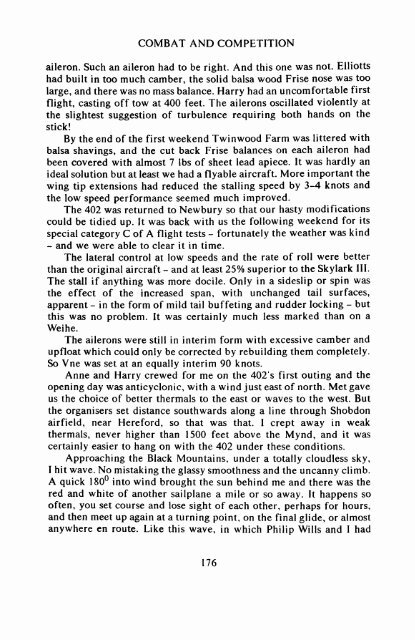COMBAT AND COMPETITION.pdf - Lakes Gliding Club
COMBAT AND COMPETITION.pdf - Lakes Gliding Club
COMBAT AND COMPETITION.pdf - Lakes Gliding Club
Create successful ePaper yourself
Turn your PDF publications into a flip-book with our unique Google optimized e-Paper software.
<strong>COMBAT</strong> <strong>AND</strong> <strong>COMPETITION</strong><br />
aileron. Such an aileron had to be right. And this one was not. Elliotts<br />
had built in too much camber, the solid balsa wood Frise nose was too<br />
large, and there was no mass balance. Harry had an uncomfortable first<br />
flight, casting off tow at 400 feet. The ailerons oscillated violently at<br />
the slightest suggestion of turbulence requiring both hands on the<br />
stick!<br />
By the end of the first weekend Twin wood Farm was littered with<br />
balsa shavings, and the cut back Frise balances on each aileron had<br />
been covered with almost 7 Ibs of sheet lead apiece. It was hardly an<br />
ideal solution but at least we had a flyable aircraft. More important the<br />
wing tip extensions had reduced the stalling speed by 3-4 knots and<br />
the low speed performance seemed much improved.<br />
The 402 was returned to Newbury so that our hasty modifications<br />
could be tidied up. It was back with us the following weekend for its<br />
special category C of A flight tests - fortunately the weather was kind<br />
- and we were able to clear it in time.<br />
The lateral control at low speeds and the rate of roll were better<br />
than the original aircraft - and at least 25% superior to the Skylark III.<br />
The stall if anything was more docile. Only in a sideslip or spin was<br />
the effect of the increased span, with unchanged tail surfaces,<br />
apparent - in the form of mild tail buffeting and rudder locking - but<br />
this was no problem. It was certainly much less marked than on a<br />
Weihe.<br />
The ailerons were still in interim form with excessive camber and<br />
upfloat which could only be corrected by rebuilding them completely.<br />
So Vne was set at an equally interim 90 knots.<br />
Anne and Harry crewed for me on the 402's first outing and the<br />
opening day was anticyclonic, with a wind just east of north. Met gave<br />
us the choice of better thermals to the east or waves to the west. But<br />
the organisers set distance southwards along a line through Shobdon<br />
airfield, near Hereford, so that was that. I crept away in weak<br />
thermals, never higher than 1500 feet above the Mynd, and it was<br />
certainly easier to hang on with the 402 under these conditions.<br />
Approaching the Black Mountains, under a totally cloudless sky,<br />
I hit wave. No mistaking the glassy smoothness and the uncanny climb.<br />
A quick 180° into wind brought the sun behind me and there was the<br />
red and white of another sailplane a mile or so away. It happens so<br />
often, you set course and lose sight of each other, perhaps for hours,<br />
and then meet up again at a turning point, on the final glide, or almost<br />
anywhere en route. Like this wave, in which Philip Wills and I had<br />
176

















